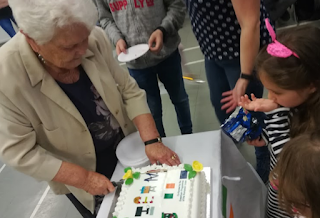In Ireland, on 9 June, we were greeted by the sun and warmth.
We are looking forward to Monday when the project activities begin.
The principal of St. Damian’s School, as well as the teachers
and pupils welcomed us, and partner countries presented their schools to each
other.
During the "tour" of the school the guests visited
classrooms and were acquainted with the school’s environment, got to know the
Irish school system and shared their experiences. We were pleasantly surprised
by the genuine interest of Irish pupils in project partner countries, schools,
hobbies and subjects.
We have concluded together that life in each country may
vary, but common values such as friendship, curiosity, kindness and openness
are the same for all of us.
The day was enriched by pupils' ice-breaking activities to
get to know each other better. With a rubber band, thread, and paper cups, each
team had to build a tower, and all participants had to get involved. The
activity was not only fun and stimulating, but also required logical thinking
and cooperation skills.
The next day began with the challenge of engineering. These were interesting and exciting activities where we had to use the skill to both plan,
visualise the product and apply the other qualities needed by engineers and
designers.
In a free and creative atmosphere, the building bridges
activity followed, where from Lego parts we had to make a bridge of a certain
length that was able to hold the proper load and was visually appealing. The
pupils not only used the existing knowledge in practice, but also discovered
hidden talents - to draw, create and present their product.
A day full of different activities. The participants of the
project expect an interesting task from newspapers, to make a stand capable of
holding a basketball ball.
After we created our own music with the help of merry beatboxers. It was so fun and interactive activity.
We visited the Physics Department of Dublin City Innovation Campus, where we learnt more about light, sounds and water print. Children were very impressed by the huge amount of water needed to produce ordinary things, from a cup of tea, to a smartphone.
We visited the Physics Department of Dublin City Innovation Campus, where we learnt more about light, sounds and water print. Children were very impressed by the huge amount of water needed to produce ordinary things, from a cup of tea, to a smartphone.
The afternoon followed the cultural visit to the impressive
Christ Church Cathedral.
Traditional evening with music, dance, Irish food and the
wonderful cake of the project ended a successful day.
Thursday's engineering challenge - building of a marble
rollercoaster. As a student from Latvia admits, such activities allow us to
realise that mathematics, physics and other exact sciences aren’t just numbers
on paper, they allow us to understand how theory works in practice. In
addition, it can be learnt in a fun and exciting way.
At the end of the day, the Science Fair took place, where
everyone had the opportunity to get acquainted with the engineering products
created during the week. It was supplemented by science projects prepared by
the pupils from the newest classes.
On Friday we visited the Explorium Science Museum. And it
isn't just a museum, it's where you come and get acquainted with science in a
fun and playful way! We gained a broad spectrum of science experience that
fuelled our curiosity.
We thank the Irish project team for the fulfilling days in
Ireland that inspired students and teachers to make pathways in Science,
Technology, Engineering, Arts and Maths (STEAM).































































